Many Legends of Localization readers alerted me to a new post on Atlus’ site. It sounds like Shin Megami Tensei IV: Apocalypse, which comes out this week, has a few lines of untranslated text – you can read the full article here. Apparently the untranslated text appears during spoiler territory near the end of the game, so rather than embed an image in the article I’ll leave the image link here for anyone who’s interested.
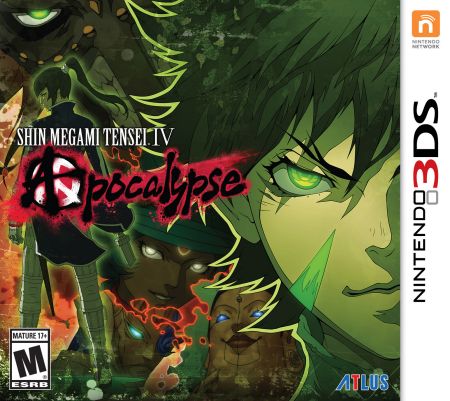 |
As the article mentions, this problem only happened with two small, obscure pieces of text in the game. What’s interesting is that this time the problem has been identified and publicly commented on before most people have even purchased the game. Normally, untranslated text in a localization simply becomes an oddity that fans discover and poke fun at much later. And rarely do companies ever comment on such problems. So it’s neat to see things play out differently this time, and especially to see the company involved being so transparent about it.
”How can a localization team possibly leave text untranslated?” is a common response to these things. The quick answer is that it happens less often that it probably would, thanks to special automated tools and procedures. But sometimes things do slip through the cracks, and the more text there is in a game – and the more complex it is – the more likely it’ll happen. Most game localizations are handled with spreadsheets of some sort, and these spreadsheets get very confusing very quickly. There’s a great, in-depth article on the subject here.
 |
| A screenshot of a basic English-to-Japanese project (via @yami_translator) |
A big game might have dozens of columns for text, multiple revisions, translation notes, editor notes, developer notes, control codes, other languages, word counts, and all kinds of other data. Things are often highlighted in all sorts of colors for specific reasons. Add in things like branching dialogue and everything becomes messier. And then don’t forget that there are multiple tabs of these – some games might have just a few dozen, but some have hundreds or more. Things get even crazier if the game is being developed as you’re working on the localization. Quality assurance teams are used to clean up any lingering problems, but the more complex a game is, the more likely that issues will slip through.
So if you ever see some untranslated text in a game, it was likely the result of three things together: a complex spreadsheet, human error, and tool error. It’s just one of those things you gotta watch out for as a translator/localizer – it can and does happen to everyone. Here are some examples:
First, this has happened in the past with Persona games:
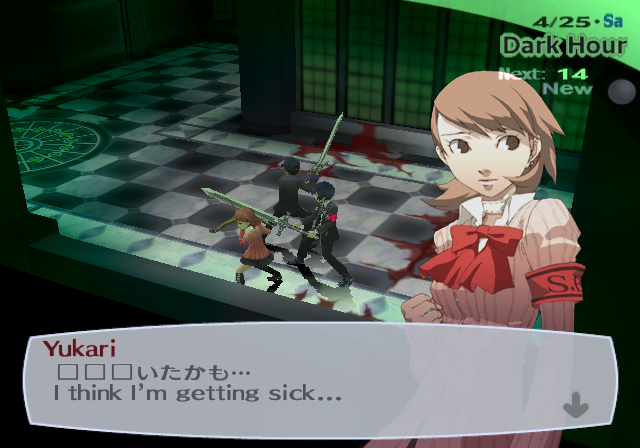 |
| Persona 3 (PlayStation 2) |
 |
| Persona 3 Portable (PSP) |
Unsurprisingly, similar mistakes appear in Harvest Moon games:
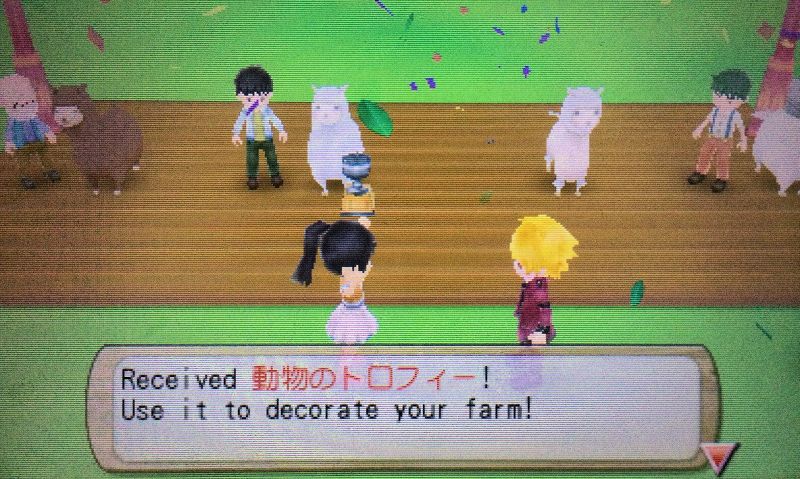 |
| Harvest Moon 3D: A New Beginning (3DS) |
We already looked at a localized game that left the credits untranslated:
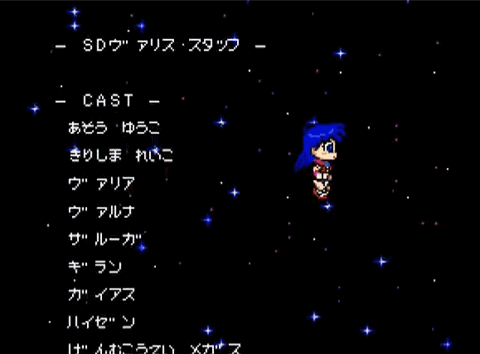 |
| Syd of Valis (TurboGrafx-CD, Genesis) |
A somewhat famous and somewhat related issue can be found in the recently released Mighty No. 9:
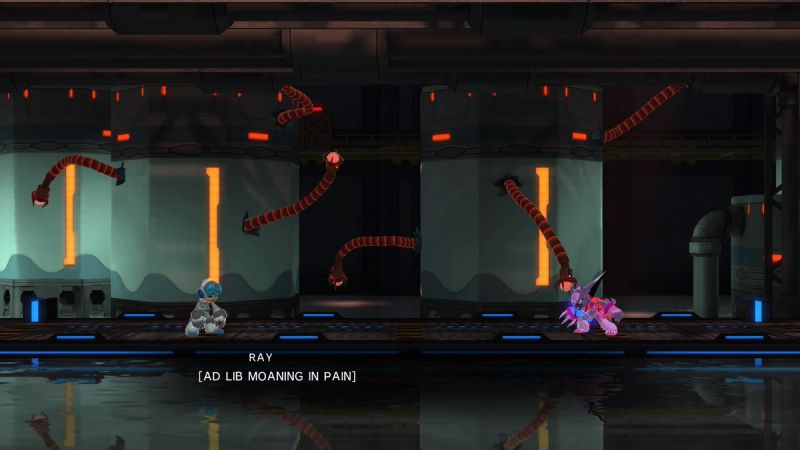 |
| Mighty No. 9 (multi-platform) |
This isn’t a Japanese-to-English-only thing, though. For example, the French version of Final Fantasy VII has many untranslated bits and pieces still in English:
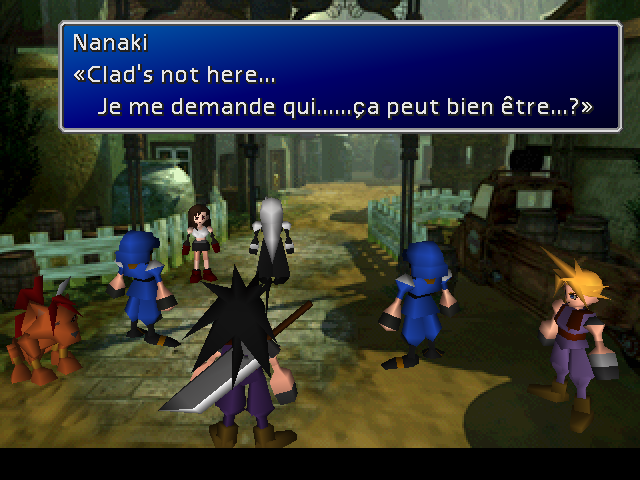 |
| Final Fantasy VII (PlayStation) |
Well-meaning fan translations goof up just as much in this category, if not more:
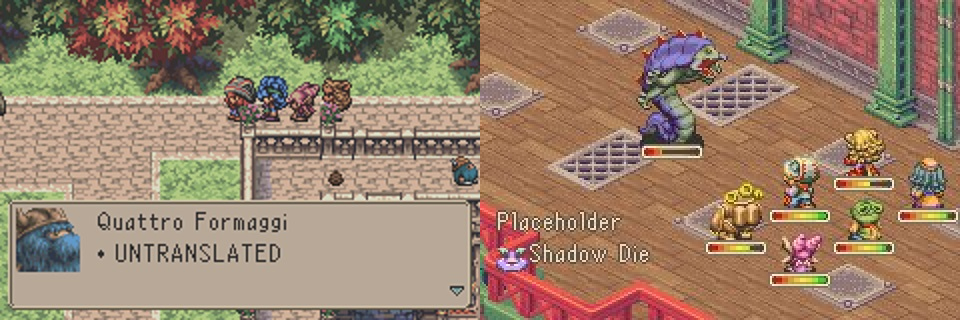 |
| Magical Vacation (Game Boy Advance) |
 |
| Star Ocean (Super Famicom) |
Even the mighty Nintendo has made this mistake!
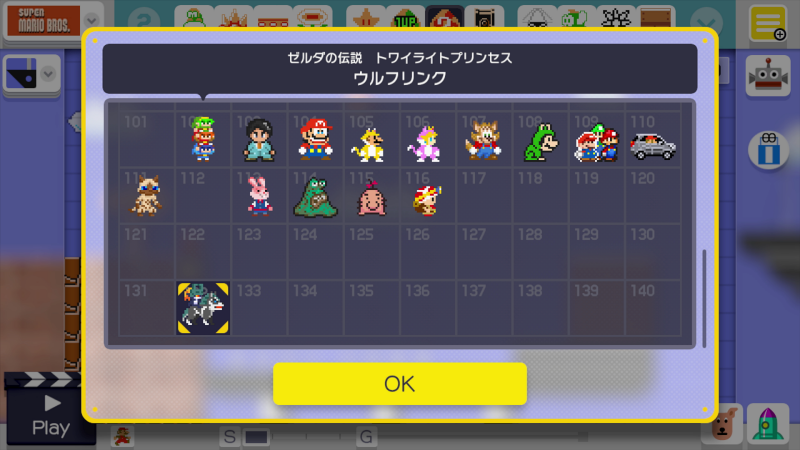 |
| Super Mario Maker (North American Wii U) |
Accidentally skipping over text is a peril every localization project faces. In fact, the risk is probably there for anyone in any kind of translation-based industry, game or not. At least with games you can kind of tell when it happens – it sticks out like a sore thumb. A related phenomenon happens when game text has been translated, but certain lines are missed during the editing phase. That’s a topic for a separate article someday, though.
Anyway, I know there are many more games that have untranslated text, and I’d love to compile a list and screenshot gallery in the near future. So if you know of any other instances of untranslated text, send me your screenshots via e-mail if you can. That saves me a ton of time, but if you know of untranslated text yet can’t get screenshots of it, that’s okay too – let me know what info you have and I’ll try to hunt it down on my own someday.


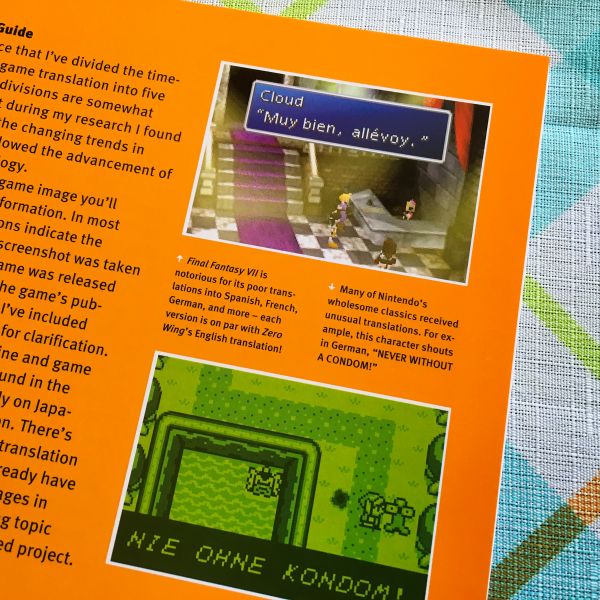

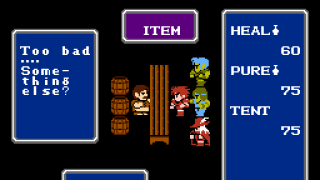
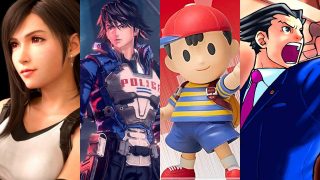
This isn’t really a case of untranslated text I guess and I can’t make a screenshot of it but it definitely is related.
There was an UbiSoft 3D platformer called Rayman 3, which got released on many platforms, among them on PC, and the PC physical version received a Polish localization handled by a Polish publisher. And they missed a part of the game’s script. But here’s the thing, Rayman 3 is a mostly dubbed game, without even an option for subtitles for speech (there is some text, obviously).
What sort of voice was left in English? A boss mocking your lack of skill? Partner encouraging you to stop staying in place? Maybe something that plays in a secret area? No. It was a CG cutscene. A mandatory one by the way. That was very weird, and I still wonder about the reason from time to time.
If google-translated Middle Eastern version of IGN is to be trusted (they did include a gameplay video), it seems the Arabic version of Street Fighter V is a weird mix of Arabic and English characters. For some reason, all moves and character names are left untranslated in English Latin characters, and whatever little is left in Arabic isn’t that well translated. And the Arabic font is very tiny compared to the English one. It’s a very… unique localization philosophy to say the least.
Oh, and The Division’s Arabic version (which is actually a thing) is mis-gendering players and NPCs very frequently, sometimes swapping genders mid-sentence.
Couldn’t be less trustworthy than the English version of IGN, anyhow.
That said, the CG cutscene in question didn’t have any important dialogue (it’s mostly a defeated boss, Razoff, spouting one last taunt at you) so it wasn’t that serious of a problem.
Oh man! I remember playing Harvest Moon: Friends of Mineral Town on GBA back in the day and seeing all kinds of weird stuff like this…lines that were in Japanese, garbage text, even some that were in German for some reason? (I was playing the English version) It was a long time ago though, so I don’t remember how to trigger them anymore. Maybe I’ll try to fiddle around with it and send you screenshots if I get anything.
That SMTIV thing is kind of funny to me. Apparently it’s hard to trigger that text, but on first glance at the screenshot it looked like an important decision you were supposed to make during the final battle, so I was picturing someone staring at their screen for a moment and going “…CRAP, NOW WHAT?!” I’m probably a bad person for laughing at this. XD
Both of the Harvest Moon untranslated text bits have screenshots on TCRF luckily. You get the Japanese text by talking to Zack a bunch (I forget if you need to get his friendship up to a certain point) and the German text by offering the Vineyard job in the first fall to Carter.
https://tcrf.net/Harvest_Moon:_Friends_of_Mineral_Town#Untranslated_Text
Friends of Mineral Town had a lot of silly mistakes in it, and I love it for that.
The 4:44 easter egg is also untranslated text, but it soft-locks the game because apparently the localized version, while it can display Japanese just fine, doesn’t expect sentences to begin with a Japanese character. That Zack line works because the sentence begins with the player’s name (which uses English, unless you edit the RAM to make it use the Shift-JIS range).
Yeah, for some reason the Harvest Moon games are consistently wonky when it comes to localization. I gotta check them out someday, but there are just so many after all these years that I think I’ll probably just have to go in chronological order to see how things changed over time.
I was writing a paper on games localization for a seminar class two years ago, and I found this amusing website when I was looking for examples of localization errors: http://harvestmoonweirdness.tumblr.com/
Ogre Battle 64 also had some untranslated lines. I can’t remember where though.
It’s not text that didn’t get translated… but Art of Fighting 3 on the Neo-Geo (and the PS2 AOF Anthology) has a really irritating bug. If you set the language to Spanish, most of the text is in Portuguese. And vice-versa.
You’ve got me curious about that Spanish FF7. Though if it’s Spain Spanish, then it’s an awful translation by default. 😀
*raises Flame shield to protect himself from angry Spaniards*
I’ve only heard bits and pieces about the Spanish localization (I thought possibly through you?), but the example I see a lot is this one:
My Spanish is very poor these days but sometime I’d love to take a look at it in more detail. Or if you ever feel like checking it out yourself, let me know – I’d love to start comparing localizations on here that aren’t just J-to-E.
You didn’t hear it from me, bud, I’ve never gotten past FF7’s first act. 🙂
That said, these screenshots show something that’s both good and bad.
The first sentence, in the first screenshot, the innkeeper seems weirded out at Cloud’s name. In the second, it’s kind of a play on another name, “Mari-Claudia” (a shortened version of María Claudia); Cloud is pronounced the same way as “Clau”, but without the D. So maybe they meant to show the innkeeper was assuming his full name is Mari-Claudia. There are some typically female names that are also used on males, usually including “María” as part of it.
In the second sentence, they straight-out translated “party” as a festive kind of party, not as in an adventuring group. They also translated “2nd Floor” as “Floor 2” instead of “en el segundo piso”, which is also a direct translation, but it’s the -correct- one.
I usually don’t bother with Spanish translations because I spend more time nitpicking it than enjoying the game itself. Don’t get me started on Ghostbusters 2016…
… Please disregard the “In the second” in the third paragraph. :p
And in the last line, it’s nitpicking -them-. Sorry, I’m running on low energy right now. x_x
It’s not that the “Mari-Cloud” is a play on another name, I think they got confused because of the “Mr”. Maybe they thought it was another name and translated his name as MariCloud, but maybe that’s just me.
Also in Harvest Moon: A New Beginning, when you talk to the Harvest Goddess on your birthday, a chunk of apparent programming text slipped in, I’ll try to get a pic next time.
What kind of translator doesn’t know the word Mister / Mr.?
… you may be right, though. I’ve seen some s##t…
MariCloud is the name that player gave Cloud. That part was translated fine and this screenshot is just bad.
Also “piso 2” is another mistranslation, since Spain is like the British and would call that the FIRST floor instead. This mistranslation crows up all the time everywhere really, even in stuff like The Big Bang Theory for example.
Also Spain Spanish is the REAL and correct Spanish. Keep your unnecessary pride out.
I think you’re the one with too much pride here.
The problem with Spanish translations is when they try to cater to both mainland and latino speakers with “neutred” scripts trying to keep any region-specific wording out (and thus lose some flavor) and end up pleasing none.
Two different scripts is the way to go.
Occasionally you’ll still see NTSC versions using a European Spanish translation. One of the weirder cases I can recall is the WiiWare game Horizon Riders, which even in the NTSC-U version the Spanish translation is European Spanish rather than Latin American Spanish.
What makes it weird is that it was published and developed by a company based in Argentina, so you’d think they would’ve done a Spanish version themselves.
Yes, that would be neat idea. Also check into the phenomenom where Japan version of games would have menu labels and such in english and it’s these things that would also get translated in German, Italian etc. versions. No such luck for the voices though most of the time… But then again, that’s something you would expect, right?
It’s a funny bad translation.
Mr (Mister) to Sr (Señor) OK
but they didn’t deleted Mr so they thought Cloud was a girl or something
and just made a new name “MariCloud” (That in spanish add Mari to a man name
is like say him homosexual)
Party was translated as fiesta instead team/partners.
By the way in the spanish version Tifa is usually called as a man too, and more girls
Apparently, what happened in FF7 is… they translated it into english(poorly), and then passed the english script out to everyone else to translate into their western language of choice. Often on very short time frames with little documentation.
Bust out the spanish-english dictionaries and go nuts, right? And that’s how the party becomes a “fiesta”.
FFVII in German also has a horrible translation and a bunch of untranslated text. My favorite example is this one right here, because the transition from English to German is so seamless
“It’s all in there, read it sorgfältig durch und unterschreibe ihn dann.”
Also a popular mistake in that translation is that they weren’t consistent with a lot of names, changing the translation randomly throughout the game. For example: Rufus is sometimes called RUFUS and sometimes RUFHAUS (which sounds quite ridiculous, since it’s pronounced “Roofhouse” in German) or Weapons are sometimes called WEAPON, WAFFE or even WAFFÉÉ, which doesn’t make any sense (that’s not even a German word).
So really, I’d be quite surprised if any translation of FFVII was worse than the original German PS1 version translation. 😀
Aha! It took a while but I finally got a screenshot of that German line:
Man, I really want to explore all these weird translations of FF7 now…
A subject for a book perhaps?
Yep, already starting to plan one that’ll hopefully pan out!
Commenting from the future that I hope this pans out
Man, this makes it look like the world of FFVII really is bilingual in the german version.
The Super Mario Maker bit has indeed been fixed.
Nice, thanks for the info!
The PS Vita port of Ar Nosurge has all of its achievements totally in Japanese. I’ll see if I can’t grab some screens.
You sure about this? That’s certainly a really lazy thing to do indeed. And besides, i’m sure the labels would be in English by this point…
Absolutely certain. It looks like they’ve fixed it since, but fortunately for localization science, I apparently already took screenshots.
http://www.perfectlydarien.com/blorg/wp-content/uploads/2016/09/2015-07-09-042633.jpg
http://www.perfectlydarien.com/blorg/wp-content/uploads/2016/09/2015-07-09-042708.jpg
Awesome, thanks for posting these!
it’s not quite the same thing, but one of my all-time favourite bits of language stream-crossing in localisation comes from the pal version of fe7, whose english script suddenly lapses into italian for half a sentence: https://miiverse.nintendo.net/posts/AYQHAAABAACNUKE9_PRQag
i’ve always found this to be a beguiling error since there’s no logical reason for this to have happened. the error wasn’t there in ntsc, the english pal script is unchanged from ntsc aside from the occasional name change, and because the pal languages for fe7 were split into two separate cartridges, this copy doesn’t even have the italian localisation on it! now that i dabble in translation myself, it’s only become even more fascinating, as have the likes of the slip-ups covered in the article
The French version of FF7 has a nonsensical string of characters and accentuated letters that may be actually the “translators” testing how characters appear in-game. A complete trainwreck of typos (“tu as peurred de la shinra”), literal translations from the already imperfect US version (“Oh, Brother” > “Oh, mon frère!”, Elder Bugah > Bugah l’aîné (Bugah the eldest kid), Doorbull > Sonnette (“doorbell”), Gi Spector > Gi Spectateur (“spectator, viewer”)), dubious name changes (Cloud > Clad, Wutai > Utai, Red 13 > Rouge 13) and occasionally devolving into nonsensical insanity (“a a dà é payé.”).
And unfinished “translations”.
“Isn’t Jenova Sephiroth’s mother?” > “Isn’t Jénova Sephiroth’s mother?”
The translators were so proud of their cultural achievement they’re credited simply as “Véronique & Margarita”. They were supposedly from Sony Europe and work was distributed between teams who didn’t coordinate between each other at all. However the mere existence of the French version (and the other two) at the time made the game a success there, and convinced Square to establish their own localization house in Europe. The translations for the later Final Fantasy games are much better, and done directly from the Japanese version, ending up far closer than the US translations which take far more liberties. The differences can get quite big and it caused some problems before (when German customers thought their German sub of FF10 wasn’t accurate to the English audio).
Haha, wow, I wonder what happened there. All I can think of is that it was some sort of file mishandling or some sort of oversight by a bunch of people during the translation, localization, and QA phases.
I find it interesting that the Japanese (for the most part) comes out fine. I’d expect it to be a garbled mess, like the mobile stadium in Pokémon Crystal: https://youtu.be/dIW7c3fiahg (Unused because the mobile adapter never came out here.)
Do you have any idea as to how the Japanese is rendered properly, from a pure technical perspective? I’d thought it’s still like the old days, where they just replaced the Japanese graphics like English graphics and go on their merry way,
Game programmer here. This is pretty much application-dependent and different from game to game. Some games may keep the original font file and just replace the Japanese characters, some games may create a new font file for English and remove the Japanese font file and some games may even create a new English font file while also keeping the orignal Japanese font file, especially games that don’t have to worry about running out of space or games that support multiple languages at once. In the case of PC and (I think) mobile games, you also have the option of using fonts installed on your system, although I suppose that would only be done in small indie games, since it’s too system-dependent and often doesn’t provide any font files that suit the style of your game. AAA games usually include the fonts directly in the game data.
I’m currently working on a port of Darksiders 1. What I think the original deverlopers of this game did was this: They made a bunch of different game packages, one for each language, which included fonts and voice overs. Whenever you installed the game in Steam or switched the game’s language via Steam, it would install the package file for that language only, or in the case of the standalone version, I think, you could select the language in the installer (although it was also dependent on your system language in some way). The Japanese package of the original game only included all the Kanjis that were actually used in the game. Now in our port, we’re actually ditching all of this. The game now already comes with all language packages right away and you can switch the languge ingame. Our new Japanese package also includes all Kanjis instead of just a few, for a number of reasons, the most important one being that the current consoles aren’t all that tight on memory and therefore we can afford larger fonts. It’s also simpler to work with that, though.
In any case, there are really many solutions to supporting different languages in a game nowadays. Back in the days of lower cartridge space, I guess the options where much more limited.
Interesting insight you got there indeed. Back in the day of cartridges, games either had to use latin letters or only kana in case they managed to get Japanese characters in. Japanese characters the became more prominent in the SNES/Mega Drive era. There was this small problem of not including furigana in games such as Legend of Zelda that would have them nowadays, most likely because of the limited space or something… I can imagine how painful it must have been for a 90s child to play these games.
Japanese games back then were often kana-only (though this makes making up some words more complicated than it needs to be) or used just the fist few dozens of jouyou kanji taught at school.
Games that used furigana existed back then (like the JP versions of Super Bonk and its sequel), and if they couldn’t display it on top of kanji characters for technical restrictions, they’d just write it in hiragana between brackets after the kanji word.
That style of furigana still shows up in more modern games, but it’s only for names.
Dunno if you’re working on that version, but I already pre-ordered it for the Wii U.
Actually some consoles DO have system fonts used in some games, generally the more modern ones with an actual OS instead of just something to boot games and spit out errors when that fails. The PSP is the one I can recall offhand that does it: PPSSPP requires you dump them from your PSP or it will use a replacement font that causes everything to look off.
Early games (as well as most fan-translations) used to have a font with only the Japanese letters, or in more lucky cases, Japanese and just the upper-case Latin set (this is the reason why so many Capcom NES games are in all-caps despite the font having more than enough room for lower-case characters: apparently back then translators had to send the text in whatever format the JP company’s computers could read, this means upper-case, and in the case of European translations like with SoM and FF8, each accentuated letter had to be written as an arbitrarily chosen kanji letter -you could try and check the ROM of the Brazilian YuYu Hakusho MD game with a hex editor with Shift-JIS support to see some of this madness in action).
Translators would just overwrite some Japanese characters with all the missing Latin characters. This is why Lufia 2, Persona 2, Suikoden 2 and Star Ocean (fan-translation)’s untranslated lines appear as a weird mix of random Latin letters, symbols, and occasional Japanese.
More modern games would have the basic Latin set for ASCII code from 0x20 to 0x7F, half-width katakana for areas from 0xA0 to 0xDF (in Multi-5 European localizations this area is used for ASCII-1256 accentuated characters, though recently devs just use the UTF-8 encoding), as well as dual byte sets of hiragana, katakana, kanji and for some reason Russian and Greek and a weird huge alternate Latin Set(a leftover from Shift-JIS)…
So, the font has everything, and characters display either as 8-pixel (ASCII range) or 12/16-pixel wide (JP range) and this was seen even in the Super Famicom era with Super Robot Taisen games, and of course now each letter has its own width. It’s the industry standard these days – even the first Mega Man Star Force game’s font, apparently fixed-width, is actually variable width but the table mistakenly has every value the same (or almost the same). Either a developer oversight or to cover another bug, probably.
This is the case for more than 2/3 of recent Japanese games (unless it’s an extra niche visual novel, or something from the Simple series), and this includes Super Mario Maker, SMT IV Final, and all of the Harvest Moon series (except maybe the N64 and PS2 games which didn’t rely on the proper ASCII Latin set, but the alternate full-width Latin set. That’s why everything is displayed correctly.
Sometimes programmers want more room in memory for the localized versions (mainly to fit in new programming for stuff like kerning, variable width fonts, Multi-5 language RAM variables and duplicates of the same graphics for each language, wider player/item names, and so on) and so, they make room for it by doing away with the kanji, a few hundred special characters only needed in CJK languages anyways that would be loaded at all times in the RAM otherwise, or take unnecessary cartridge space. This is why the Persona 3/4 screenshots have the untranslated sentences with working kana but the kanji replaced with dummy square symbols.
And some devs go the extra mile and blank out all traces of Japanese from the font. So if you have untranslated text you’ll just hear the letter bleep sound effects as the text is “written”, but the message box appears empty. This is the case with the US version of Rhapsody DS if you use cheats to access the “localized out” side stories.
That overwriting of letters happens maybe in the SNES Era because of the space in the ROM. But we as example just adding the letters at the and of the ISO in Suikoden 1 for the german translation with letters like
äÄüÜÖöß etc.
This kind of reminds me how Rune Factory 4 has an odd bug where occasionally a line of dialogue will display the Japanese version instead of the English. It seems to be really rare though and I’m not sure exactly what causes it, otherwise I would try to replicate it and get a picture for you.
It sounds like you’re referring to this, but I don’t know if it’s an isolated event or not:
Someone on Twitter sent that to me the other day (maybe it was you)
Great post thank you so much
It’s too bad you never really played Persona 3. It’s a very good game. If you ever did go back to finish it, I recommend the Persona 3 fes version on the ps2. The only thing the psp version really has on it is the updated battle system from persona 4. This means that you can directly command your party members instead of being at the mercy of the AI. That is very important to some people. I personally enjoyed it even if Mitsuru would never stop casting Marin Karin on everything that moved. The female main character choice for p3p is interesting but it isn’t canon so I don’t consider p3p required. Especially since p3p doesn’t include the “the answer” storyline like fes does.
Thanks for the info, it helps clear the confusion a bit. I have some version for the PS3 that I bought off of PSN, but I can’t recall what version it was. I’m feeling more and more like I’m missing out, so maybe I’ll dig my PS3 out of the closet and start over sometime.
Personally, my favorite example is more of a “only half-translated” thing: The part in Breath of Fire 2 where you talk to the old man in the jail in the first town and he says is “All I wanted was to sell cakes kujira manju.” Presumably they left it like that to avoid people getting the idea that he was selling whale-meat cakes, but it’s still clunky as hell.
Breath of Fire 2’s script makes me think it’s a first pass of a literal translation that got quickly reviewed (for stuff like alcoholism, and the puff puff scene) and then they inserted it in golden carts and hurled it out the door. It’s not wrong mostly, but it’s overly literal down to the typical Japanese grammar ellipses to the point of being unreadable at times (doesn’t help it loses information from the missing particles).
Your example is exactly what a translation draft would have: translation notes. I think one of the betas for a Phantasy Star game on the MD has something very similar. To be fair, if they translated it that way, NoA would have rejected it, so maybe they put it there to try an figure out what translation would be best to get the meaning across Nintendo’s censors (who were sleeping anyways to the point of allowing religious references even Sega was rejecting at the time).
Breath of Fire 2’s translation was an utter joke. I wish they could have been more productive and at least properly translated the GBA port, but nope, they just stuck with the lazy route and kept the hack job they did for the SNES version. Utterly disappointing. Capcom USA is so lazy. Would it have honestly killed them to put some effort into it?
The really sad thing is that the GBA port didn’t bother to redo the translation at all, probably because they didn’t feel like spending any money on it.
Considering much of the menu text in Megaman Battle Network 4 and Megaman and Forte, both recent translations, could have only been Babelfish’d, I don’t think they would have even bothered.
From what I can tell, what’s even weirder is that the prototype version of the English release had many more mistakes/typos, yet the current amount of problems was considered okay. I guess there must’ve been a lack of time to fix everything or something.
The strangest part is that “cakes kujira manju” doesn’t follow English or *Japanese* word order.
RPGFan just covered that translation slip the other day too. And I remember Persona 3 has one other untranslated text goof in the original PS2 version when you try to sell something you can’t sell at the pharmacy.
Thanks, I’ll keep an eye out for this.
No problem. I wish I had my old PS2 hooked up or I’d instantly send you a screenshot, because it takes no time at all to do in-game.
Speaking of hackjob translations, this happens a few times in Castle Shikigami 2 (may its infamy never die). They have both lines they dubbed in English but didn’t translate the text for and lines they translated but neglected to record English for.
Maybe it’s because I’m coming from an engineering background, but I’m sort of baffled that there aren’t extremely robust tools for making the translation process less strenuous and error-prone.
Oh man, I’ve heard great things about Shikigami’s localization.
Fan translators and professional translators have all come up with sorts of approaches and tools for localization projects, but I don’t think there’ll ever be one silver bullet solution. Every game is different, and there’s just so much information that translators/localizers/developers need to have that it’ll always be a complicated affair. I’m sure things will continue to advance and improve of course, though.
Castle of Shikigami III’s translation is also nonsense, which is supposedly because the game never made any damn sense to begin with.
The explanation that Atlus gave made it sound like they had to play through the game in order to find that the line of text even existed, not just where it showed up in the game. How common is that? Or is there another reason why they gave the explanation they did?
Shouldn’t there be some other method that the localization team can use to extract the text from the game rather than playing through it and seeing every line?
They probably had the text in the Excel sheet, but the problem is that said sheet didn’t actually say where that bit of text came from. Presumably they thought it was just another one of those “dummied-out” lines and didn’t bother, although “didn’t bother” is a bad way to put it when it was more like “tried to see if it was reproducible, couldn’t, figured it must have been dummied out”.
As someone who’s done translation hacks before I try to translate every line even if I can’t find where it comes from, but that’s dangerous because on top of potentially causing more programming headache, the fact you don’t have possible context for it could end up messing stuff up and your brain could end up creating context for things that don’t actually exist. It’s tough because the game’s programming is obviously not a human and cannot tell you where the lines pop up except in a sea of code, and no human wants to mentally parse that sea of code to track down where it comes from, especially if your job is as a translator and not a high-level programmer.
Yup, been helping on a fan TL for a fangame and we bumped that issue a few times in missing things, not having the script files themselves for a long while before the dev helped lead to more then a few lines just being found whenever we randomly threw ourselves at the game again(thankfully we now have a script, so its just working things out and TLing stuff while we wait for the full release of the game, its only like half finished)
Conquest of the Crystal Palace is an interesting case. None of the stage names are translated into English. There are other instances of untouched Japanese, such as the Kanji for “Use” over the selected item, and the Kanji left on shop items, although the Kanji items you pick up during normal play are changed into more traditional-looking items(such as the Kanji for “sword” being replaced by an actual sword)
The story for Conquest of the Crystal Palace was heavily changed in the US release, yet they left the kanji stuff unchanged. Weird.
I think Hagane for the SNES is similar, none of it is translated save for 5 title cards for stages, and a (dubious) translation of the intro scroll in red. Untranslated kanjis abound in the item menus.
Final Fantasy XIV has this pop up every now and then with a new patch. Sometimes enemy names, item names, or pop up info boxes will have Japanese text instead of English, though the dev team is usually quick to fix those.
I remember a weird instance in Harvest Moon: Friends of Mineral Town, where talking to Zack at a certain time would cause him to speak in untranslated Japanese text. Doesn’t seem so odd now, but even weirder than that? Talking to Carter at some point would cause him to speak in German! At least the Japanese text is easier to explain!
One of my ‘favourite’ half-translations is the Dutch version of Muramasa: The Demon Blade for Wii.
Voice track: Japanese
Dialogue and subtitles: Dutch
Items and other words related to the game mechanics: English
Atleast is was consistent.
Square did that too for European versions of Dissidia on the PSP. A weird mix of cutscene subtitles fully translated in German/French/etc, and everything else relating to the menus and actual game mechanics still in English.
I heard from people that the Italian translation of Fire Emblem Fates – Conquest haves many lines during the support dialogues and other kinds of interations between characters outside the main plot left in English. Note, only Conquest haves this issue – Birthright and Revelation are fully translated with no issues.
Here’s another for the Persona 3 pile!
http://imgur.com/OQOHcC4
This comes from the PSP version, I believe it was when Theo first opens the Compendium.
The game Nostalgia of nintendo Ds has a message saying
“There is no message!”
That message it’s really a dummy that is repeated inside the script,
and I never thought see that making the spanish-fan translation
appearing in the game.
The same with Wild Arms 2, Brad: Namumi! lol
“[Brad goes down the cliff. On his way, he senses something.]
Brad: What?! Who’s there?!
[A puppy appears.]
Brad: Oh, a puppy. Come on. Don’t bark, please.
Voice: Hey, did you hear something over here?
[Brad hides behind a tree.]
Brad: Namumi!
Voice: Oh, it’s just a puppy. Scared me. What a waste of time.
Let’s go. I’m not going to let the others get all the credit.
[Brad comes out from hiding. The puppy has a berry with him.]
Brad: You saved my butt, buddy. Wow. That took guts.
You probably came into the forest to avoid the rain too.
Let’s get out of here together. “
Literally every win quote in the Xbox Live Arcade port of King of Fighters 98 Ultimate Match (NA Version) is untranslated, unless they changed it this year…doubt it though. It is SNK. =P
I can absolutely vouch for the complete insanity that is Castle Shikigami 2 (they don’t even get the game name right in the manual!).
I went through every single piece of dialogue with an old friend years ago, and it’s become quite the inside joke to this day. Maybe I should try recording everything since I still have that save?
3 was just as breathtaking, but I never owned a wii (and can’t run Dolphin).
Anyway, love everything you’re doing Sir Tomato. Just finished reading the Bad Translations book and had to come here asap.
I’m eternally grateful for all the work you put in to Mother 3 as well. Your translation also holds the honour of the very first game to make me cry like a baby.
Keep up the good work!
-Nick
Heh, I’ve been helping a bit with a fan started TL project for a fangame based on Touhou and MM Battle Network(ShanghaiEXE Genso Network if you happen to care), and we’ve run into these issues occasionally, some from pieces we just plain missed, since until recently we weren’t doing this with help from the dev, so we were manually locating all the damn text and spreadsheeting it, and once we did get the script list some early stuff got overlooked still, and some of it from something like misaligned control codes(as mentioned, the dev’s helping us, and that includes native implementation in the game alongside the JP text), I’m thankfully not actually TLing, more just helping things sound right, be spelled right, and fit text limitations, so I can understand the pains of realizing “Oh shit we missed something” when the latest demo version came out and we had instances of that, its an incredibly easy mistake even with spreadsheets and script access(we had pieces we’d misplaced for where they ended up, so the text broke their intended textbox due to being thought for a longer box)
Ar Tonelico was a wonderful game on the PS2 that the localization team took a lot of time working with creator Tsuchiya Akirato make sure they have a pretty good translation. The sequel though…was rushed in in half the time and it showed. Bugs, typos, grammatical errors and Japanese text still in the game. There is even a fan delocalization project that has fixed the numerous problems with programming and the script in the game http://www.at2.metalbat.com/?p=765. The worst bug was a story boss that needed to be killed in 3 turns or they would use an attack that would freeze the game. I’m trying to find pictures or video of some of the errors and Japanese text but it’s looking like I might have to play through it again and get it myself.
Final Fantasy XIV tends to have some Japanese text slip by in the localized versions of the game. I remember one scene that was pretty intense and then it got ruined when the text box had the NPC suddenly speaking in Japanese. Fortunately, the devs are quick to fix this.
I know this article was published in September 2016, but I was looking for something specific and found treasure. Anyway, I needed to swing by with my own tale – Demon King Box for Nintendo 3DS, which can be bought for less than a fiver on the EShop. It’s a tower defense game with excellent gameplay and I unironically love it to bits, but the English translation is incredibly rough and feels like it might have been done with heavy help from dictionaries. I can’t account for other translations (I felt it unwise to test German even though I can read it when English was already so wrung) and the first minion leader, Pohdark, gets renamed several times during the story as different translators pick up and put down the plot. I am uncertain if this game misses any actual text – it requires a lot of grinding so I only got two thirds of the way to the end – but if it was fully translated, it might be a hit instead of an odd cult game spread by word of mouth. A real shame, I think. Thanks for this informative and interesting article! I’m glad to find out the reasons behind font choices and lapses of translation.
There are a few that I’ve seen in the freeware game Farethere City, but most can be guessed at, anyway, and all are because it’s part of image files rather than text. Those seem somewhat trickier to deal with.
The most notable one is in the Path of Rebirth connected to Grove Club Village. Enter the inn, then go to the room before the room with the bath. There’s a large kanji on the floor. I kind of wish Pigula would have read it, but I guess that didn’t happen in the original.
There’s also kanji in the otherworld on the building corresponding to your store. Again, we’re just kinda left not knowing what it means.
Pokemon Crystal international version has lots of untranslated text about mobile phone function, but because it never be used, only access with cheats.